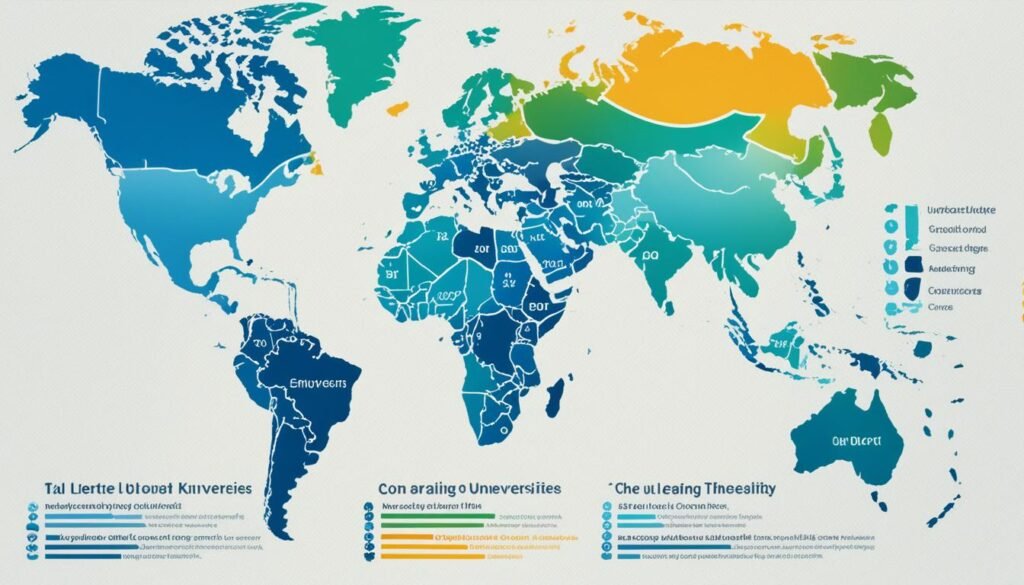Universities In World With Ranking And Review Welcome to our comprehensive guide on the top universities in the world, complete with rankings and reviews. In this article, we will delve into the prestigious rankings provided by THE (Times Higher Education) that assess university performance on a global scale. Whether you are a student, an academic, or someone interested in higher education, this information will help you make informed decisions and gain valuable insights into the leading institutions worldwide.
THE has been at the forefront of providing trusted performance data on universities since 2004. Their rankings cover various aspects such as research, impact, and teaching, providing a holistic assessment of university performance. From global rankings to impact rankings based on the United Nations’ Sustainable Development Goals, THE offers a comprehensive view of university excellence in different domains.
In this article, we will explore THE World University Rankings, the Impact Rankings, and the Teaching Rankings. We will also discuss regional and thematic rankings, the methodology behind these rankings, and the representation of different countries in the rankings. Let’s dive in and discover the top universities that are shaping the future of higher education.
Key Takeaways: Universities In World With Ranking And Review
- THE provides comprehensive rankings that assess university performance globally.
- The rankings cover research, impact, and teaching, offering a holistic view of university excellence.
- THE World University Rankings evaluate research-intensive universities across their core missions.
- The Impact Rankings measure universities’ progress towards the United Nations’ Sustainable Development Goals.
- The Teaching Rankings focus on institutions that prioritize student engagement and success.
THE World University Rankings
When it comes to identifying the best universities worldwide, THE World University Rankings is the go-to resource. This comprehensive list evaluates research-intensive universities based on their core missions, including teaching, research environment, research quality, industry collaboration, and international outlook.
The rankings employ 18 performance indicators to provide a holistic assessment of universities’ strengths and achievements. These indicators cover various aspects of university performance and contribute to the overall ranking and subject-specific rankings. Institutions are ranked based on their scores in each indicator, allowing for a comprehensive evaluation of their capabilities and expertise.
Additionally, THE World University Rankings includes regional and thematic rankings that provide deeper insights into universities’ performance within specific contexts. These rankings include the Arab University Rankings, Asia University Rankings, Latin America University Rankings, World Reputation Rankings, and Young University Rankings.
The Table below highlights the top 5 universities in the world according to THE World University Rankings 2022:
| Rank | University | Country |
|---|---|---|
| 1 | University of Oxford | United Kingdom |
| 2 | California Institute of Technology | United States |
| 3 | Stanford University | United States |
| 4 | Harvard University | United States |
| 5 | University of Cambridge | United Kingdom |
These rankings provide valuable information for students, academics, and leaders in making informed decisions about higher education. They highlight the global landscape of top universities and promote excellence in the field of higher education.
THE Impact Rankings

THE Impact Rankings provide a unique assessment of universities’ progress in addressing the United Nations’ Sustainable Development Goals (SDGs). As the only global league table that measures universities’ impact based on the SDGs, these rankings play a crucial role in promoting sustainable development and driving positive change.
The rankings consist of an overall ranking as well as 17 individual tables, each dedicated to measuring universities’ progress on a specific SDG. These tables provide a comprehensive view of how universities are contributing to the global goals in areas such as climate action, gender equality, quality education, and clean energy.
“The Impact Rankings offer valuable insights into universities’ commitment to sustainability and social responsibility. They highlight the crucial role that higher education institutions play in shaping a better future for our societies and planet.” – [Author Name]
By assessing universities’ efforts to address the SDGs, these rankings encourage collaboration and innovation among academic institutions worldwide. They recognize universities for their contributions and inspire others to take meaningful action towards achieving sustainable development.
Universities that prioritize sustainability and actively contribute to the SDGs can positively impact rankings. This recognition enhances their reputation and attracts students, faculty, and partners who value their dedication to building a more sustainable and equitable world.
Image:
| SDG | University | Ranking |
|---|---|---|
| SDG 13: Climate Action | University of California, Berkeley | 1 |
| SDG 5: Gender Equality | University of Iceland | 2 |
| SDG 4: Quality Education | University of Cambridge | 3 |
| SDG 7: Affordable and Clean Energy | Stanford University | 4 |
The table above showcases the top-ranked universities for specific SDGs. These institutions demonstrate exceptional dedication to addressing the respective goals and serve as inspiring examples for others to follow.
THE Impact Rankings are a powerful catalyst for sustainable development within the global higher education landscape. They provide a comprehensive framework for assessing universities’ contributions to the SDGs and inspire action towards creating a more just, inclusive, and sustainable world.
Teaching Rankings

When it comes to assessing excellence in higher education, the Teaching Rankings by THE (Times Higher Education) take center stage. These rankings specifically focus on institutions that prioritize teaching over research-intensive activities. By doing so, they highlight the importance of student engagement and student success in the learning experience.
In addition to global rankings, THE also provides specialized rankings for specific regions and countries. For example, the Japan University Rankings is the only teaching ranking published by THE that evaluates universities in Japan based on teaching quality and outcomes.
What sets the Teaching Rankings apart is their emphasis on the impact universities have on students’ educational journey. By valuing teaching excellence and student engagement, these rankings empower students to make informed choices about their higher education options.
Institutions that prioritize teaching over research-intensive activities are recognized in the Teaching Rankings by THE, which highlight student engagement and success as key factors in fostering a qualitatively rich learning environment.
The Japan University Rankings, in particular, shed light on the teaching quality and outcomes offered by universities in Japan. This provides prospective students with valuable insights and aids them in making decisions that align with their educational aspirations and goals.
These rankings not only encourage higher education institutions to prioritize effective teaching methods but also promote a culture of student success and engagement. By placing students at the heart of the evaluation process, the Teaching Rankings contribute to the continuous improvement of teaching practices worldwide, benefitting both students and institutions alike.
Regional and Thematic Rankings

THE publishes a range of regional and thematic rankings to provide deeper insights into universities’ performances. These rankings offer a more specific evaluation of universities in different regions and based on specific themes or criteria. Let’s explore some of the notable regional and thematic rankings:
1. Arab University Rankings
The Arab University Rankings recognize the top-performing universities in the Arab region. These rankings take into account factors such as research output, teaching quality, and international collaborations.
2. Asia University Rankings
The Asia University Rankings highlight the best universities in Asia. These rankings consider indicators such as academic reputation, research publications, and international diversity.
3. Latin America University Rankings
The Latin America University Rankings assess the performance of universities in Latin America. These rankings evaluate factors such as research influence, teaching reputation, and industry engagement.
4. World Reputation Rankings
The World Reputation Rankings focus on universities’ global reputation based on the opinions of academics worldwide. These rankings provide insights into the perception and esteem that universities hold in the academic community.
5. Young University Rankings
The Young University Rankings identify the top young universities globally. These rankings consider universities established within the last 50 years and evaluate their performance across various metrics, including research impact and industry income.
These regional and thematic rankings enable a more nuanced evaluation of universities’ performance and further contribute to the understanding of their strengths and areas of expertise.
Thematic Rankings Insights
“THE’s regional and thematic rankings allow institutions to showcase their expertise in specific areas and establish themselves as leaders in their respective regions. These rankings provide valuable insights for students, researchers, and policymakers when making decisions regarding higher education.”
By producing rankings that go beyond global assessments, THE offers a more comprehensive view of university performance, empowering stakeholders to make informed choices based on their regional or thematic preferences.
The Times Higher Education World University Rankings 2022

The Times Higher Education World University Rankings 2022 is a highly anticipated and comprehensive assessment of over 1,600 universities across 99 countries. These rankings serve as a benchmark for universities around the globe, evaluating their performance in various key areas.
The rankings consider aspects such as teaching, research, knowledge transfer, and international outlook, providing valuable insights into the overall quality and reputation of institutions. By using 13 performance indicators, including research citations and survey responses from scholars, THE World University Rankings aims to offer a comprehensive and accurate representation of the global higher education landscape.
It is worth noting that the University of Oxford has maintained its position at the top of the rankings for the sixth consecutive year. This remarkable achievement highlights the institution’s unwavering commitment to excellence in research, teaching, and international collaboration.
The Times Higher Education World University Rankings 2022 not only recognize the research capabilities of universities but also emphasize the importance of fostering an international outlook and promoting knowledge transfer. These aspects are crucial in preparing students for a globalized world and in driving innovation and progress in society.
China, too, has made significant strides in the rankings, with two of its institutions securing a place in the top twenty for the first time. This achievement reflects China’s growing prominence in the global higher education landscape and its commitment to fostering academic excellence.
With their comprehensive approach, the Times Higher Education World University Rankings 2022 provide valuable guidance for students, academics, and policymakers alike. They serve as a compass for identifying institutions with strong international reputations, research capabilities, and dedication to teaching. These rankings play a crucial role in helping individuals make informed decisions about their educational and career paths.
| Rank | University | Country |
|---|---|---|
| 1 | University of Oxford | United Kingdom |
| 2 | Stanford University | United States |
| 3 | Harvard University | United States |
| 4 | California Institute of Technology | United States |
| 5 | Massachusetts Institute of Technology | United States |
These rankings not only recognize the achievements of top-tier institutions but also encourage healthy competition and the continuous improvement of universities worldwide. Institutions that aspire to be at the forefront of higher education can utilize the Times Higher Education World University Rankings as a roadmap for enhancing their international profile, research output, teaching quality, and knowledge transfer initiatives.
Key Takeaways:
- The Times Higher Education World University Rankings 2022 evaluate over 1,600 universities across 99 countries.
- These rankings consider teaching, research, knowledge transfer, and international outlook as key performance indicators.
- The University of Oxford has secured the top spot for the sixth consecutive year.
- China has two institutions in the top twenty for the first time, highlighting its growing prominence in global higher education.
- These rankings provide valuable guidance for students, academics, and policymakers in making informed decisions.
Country Representation in Rankings

When it comes to university rankings, the United States takes the lead with the highest number of institutions represented. A total of 183 universities from the United States have made it into the rankings, showcasing its prominence in global higher education.
However, other countries are also making their mark in the rankings. China, for instance, has climbed up the ranks and now boasts the fifth highest number of institutions in the top 200. Surpassing Canada and on par with the Netherlands, China’s universities have proven their worth on the global stage.
It’s not just the familiar names that dominate the rankings. Institutions from new countries are also gaining recognition. Azerbaijan, Ecuador, Ethiopia, Fiji, Palestine, and Tanzania have all found representation in the rankings, highlighting the increasing diversity and global reach of higher education.
Take a closer look at the countries with the most institutions in the top 200 below:
| Rank | Country | Number of Institutions |
|---|---|---|
| 1 | United States | 183 |
| 2 | United Kingdom | 80 |
| 3 | Germany | 43 |
| 4 | Australia | 29 |
| 5 | China | 25 |
These rankings reflect the ever-evolving landscape of global higher education and the growing reputation of universities from around the world. It is a testament to the tireless pursuit of excellence in teaching, research, and international collaboration by institutions across different countries.
Pillar Rankings
The Times Higher Education World University Rankings include pillar rankings that highlight excellence in specific areas. These rankings provide a more focused evaluation of universities’ strengths in different aspects of higher education. Let’s take a closer look:
Teaching Pillar
Harvard University is recognized as the leader in the teaching pillar. With its comprehensive and innovative teaching methods, Harvard continues to set the standard for educational excellence. Students at Harvard benefit from exceptional academic programs and dedicated faculty members who are committed to providing an outstanding learning experience.
Research Pillar
The University of Oxford is renowned for its outstanding research contributions and is consistently ranked at the top of the research pillar. Oxford’s commitment to advancing knowledge and pushing the boundaries of research has established it as a global leader in various disciplines. The university’s research output and impact have made significant contributions to the advancement of academia.
International Pillar
Macau University of Science and Technology takes the lead in the international pillar. With a strong emphasis on global collaboration and cultural diversity, Macau University of Science and Technology promotes an international outlook and offers various international programs and partnerships. The university’s commitment to fostering global perspectives and connections sets it apart in the international higher education landscape.
These pillar rankings highlight the strengths and achievements of universities in specific areas, including teaching, research, and internationalization. It offers valuable insights into the diverse capabilities and strengths of institutions worldwide.
Methodology and Data Collection

The Times Higher Education World University Rankings employ a rigorous methodology to evaluate university performance in various domains. The rankings are based on comprehensive data collection and analysis of performance indicators in the areas of teaching, research, knowledge transfer, and international outlook.
Throughout the data collection process, over 1,600 universities from around the world submit their relevant information for evaluation. This ensures a broad representation of institutions in the rankings, reflecting the global landscape of higher education.
The rankings consider a wide range of performance indicators, including but not limited to research citations, academic surveys, industry collaborations, and international reputation. These indicators provide valuable insights into the quality and impact of universities on a global scale.
To ensure the accuracy and validity of the rankings, the data collected undergoes a thorough review and calibration process. The Times Higher Education team meticulously analyzes the submitted data, accounting for various factors and adjusting for potential biases.
Moreover, to capture a comprehensive picture of each university’s performance, the rankings utilize over 108 million citations and survey responses from scholars worldwide. This extensive data collection enables a robust evaluation of universities’ research impact and teaching quality.
The Times Higher Education World University Rankings are widely recognized and trusted by students, teachers, governmental organizations, and industry experts. The rankings’ reputation stems from the meticulous methodology and data collection process, which ensures an accurate and insightful assessment of university performance.
Sample Table: Performance Indicators
| Performance Indicator | Description |
|---|---|
| Teaching Quality | Evaluates the quality of teaching and pedagogical approaches |
| Research Impact | Assesses the impact of research outputs and citations |
| Knowledge Transfer | Measures the effectiveness of knowledge dissemination and collaboration with industry |
| International Outlook | Ranks the level of international diversity, collaboration, and partnerships |
The above table provides a sample of performance indicators used in the Times Higher Education World University Rankings. These indicators serve as key metrics to evaluate universities’ overall performance and influence their rankings.
World Reputation Rankings
2024 Top 200 Universities in the world
Recent Articles
Conclusion
The rankings provided by THE (Times Higher Education) offer valuable insights into the top universities in the world. These rankings assess university performance in various areas, including research, teaching, impact, and international collaboration. They provide students, academics, and leaders with vital information to make informed decisions about higher education.
By highlighting the strengths and achievements of institutions globally, these rankings promote excellence in higher education. They recognize the efforts put forth by universities in creating impactful research, fostering a conducive learning environment, and fostering international collaborations.
With their rigorous methodology and extensive data collection, THE rankings have become trusted and widely referenced by students, teachers, governments, and industry experts. The rankings serve as a benchmark for universities and drive continuous improvement in the field of higher education.
FAQs
What are the global university rankings based on?
A: The global university rankings are based on various factors such as academic reputation, faculty quality, research output, and international diversity of students and faculty.
Q: How often are the university rankings updated?
A: University rankings are updated annually, with new editions released each year reflecting the latest data and trends in higher education.
Q: Which universities typically rank in the top 10 globally?
A: The top 10 universities globally usually include institutions known for their excellence in research, teaching, and innovation such as Harvard, Stanford, MIT, and Cambridge.
Q: Can you provide information on the regional rankings of universities?
A: Regional rankings categorize universities based on their performance within a specific geographic area such as Europe, Asia, or Latin America.
Q: How can I access the QS World University Rankings for 2024?
A: The QS World University Rankings for 2024 can be accessed on the official QS website or through reputable sources that publish the rankings.
Q: What is the significance of university rankings for students and research?
A: University rankings play a crucial role in guiding students and researchers in selecting institutions with high levels of academic excellence, resources, and prestige.
Q: How can universities use rankings to fuel their academic reputation?
A: Universities can leverage their rankings to attract elite students, faculty, and research funding by showcasing their environmental, art, and graduate programmes along with their strong network and research capabilities.
Source Links
- https://www.timeshighereducation.com/world-university-rankings
- https://www.topuniversities.com/university-rankings/world-university-rankings/2020
- https://www.timeshighereducation.com/world-university-rankings/2022/world-ranking





